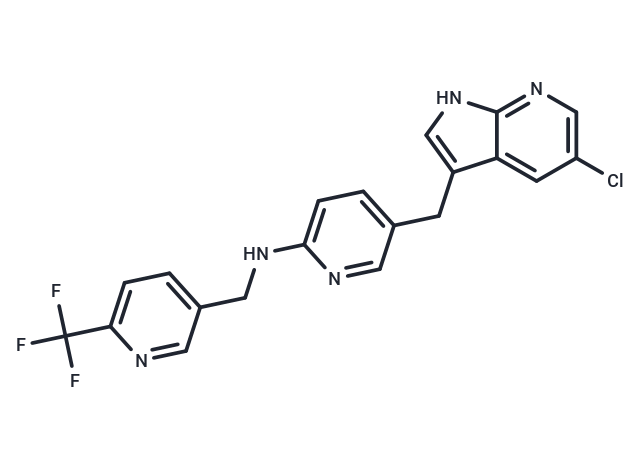Shopping Cart
- Remove All
 Your shopping cart is currently empty
Your shopping cart is currently empty

Pexidartinib (PLX-3397) is a capsule containing a small-molecule receptor tyrosine kinase (RTK) inhibitor targeting KIT, CSF1R, and FLT3, with potential antineoplastic activity.

| Pack Size | Price | Availability | Quantity |
|---|---|---|---|
| 5 mg | $40 | In Stock | |
| 10 mg | $56 | In Stock | |
| 25 mg | $87 | In Stock | |
| 50 mg | $123 | In Stock | |
| 100 mg | $156 | In Stock | |
| 200 mg | $213 | In Stock | |
| 500 mg | $369 | In Stock | |
| 1 mL x 10 mM (in DMSO) | $44 | In Stock |
| Description | Pexidartinib (PLX-3397) is a capsule containing a small-molecule receptor tyrosine kinase (RTK) inhibitor targeting KIT, CSF1R, and FLT3, with potential antineoplastic activity. |
| Targets&IC50 | FLT3:160 nM, c-Kit:10 nM, CSF1R:20 nM |
| In vitro | In M-NFS-60, Bac1.2F5 and M-07e cells, Pexidartinib inhibits the CSF1-dependent proliferation with IC50 of 0.44 μM, 0.22 μMand 0.1 μM, respectively. [1] |
| In vivo | In MMTV-PyMT mice, Pexidartinib (40 mg/kg, p.o.) significantly inhibits both steady-state and PTX-induced tumor infiltration by CD45+CD11b+Ly6C?Ly6 g?F4/80+. Pexidartinib/PTX therapy also results in a significant reduction in CD31+ vessel density within mammary tumors, paralleling induction of apoptosis and necrosis. [1] In C57 mice bearing GL261 tumors, Pexidartinib (p.o.) inhibits glioblastoma invasion. [2] In cmo mice, PLX3397 significantly attenuates autoinflammatory disease by decreasing the erosive bone lesions in tails and paws and the levels of circulating MIP-1α. [3] In mice bearing B16F10 melanomas, Pexidartinib (45 mg/kg, p.o.) enhances CD8-mediated immunotherapy of melanoma. [4] |
| Kinase Assay | Competitive binding fluorescent polarization assay: Recombinant Hsp90β, TAMRA-radicicol, or various concentrations of NVP-BEP800 is added in assay buffer (50 mM TRIS pH 7.4, 5 mM MgCl2, 150 mM KCl, and 0.1% CHAPS), mixed, and incubated at room temperature for 30 to 45 minutes prior to reading. The 2D-FIDA-based HTS assay based on confocal technologies monitors the decreased fluorescence polarization on displacement of the high affinity ligand TAMRA-radicicol from Hsp90β by NVP-BEP800. The concentration of NVP-BEP800 which inhibits Hsp90β by 50% is determined from the competition curve. |
| Alias | PLX-3397 |
| Molecular Weight | 417.81 |
| Formula | C20H15ClF3N5 |
| Cas No. | 1029044-16-3 |
| Smiles | FC(F)(F)c1ccc(CNc2ccc(Cc3c[nH]c4ncc(Cl)cc34)cn2)cn1 |
| Relative Density. | 1.458 g/cm3 (Predicted) |
| Storage | Powder: -20°C for 3 years | In solvent: -80°C for 1 year | Shipping with blue ice. | ||||||||||||||||||||
| Solubility Information | 10% DMSO+40% PEG300+5% Tween 80+45% Saline: 7.7 mg/mL (18.43 mM), suspension.In vivo: Please add the solvents sequentially, clarifying the solution as much as possible before adding the next one. Dissolve by heating and/or sonication if necessary. Working solution is recommended to be prepared and used immediately. DMSO: 45 mg/mL (107.7 mM), Sonication is recommended. Ethanol: < 1 mg/mL (insoluble or slightly soluble) | ||||||||||||||||||||
Solution Preparation Table | |||||||||||||||||||||
DMSO
| |||||||||||||||||||||

Copyright © 2015-2025 TargetMol Chemicals Inc. All Rights Reserved.